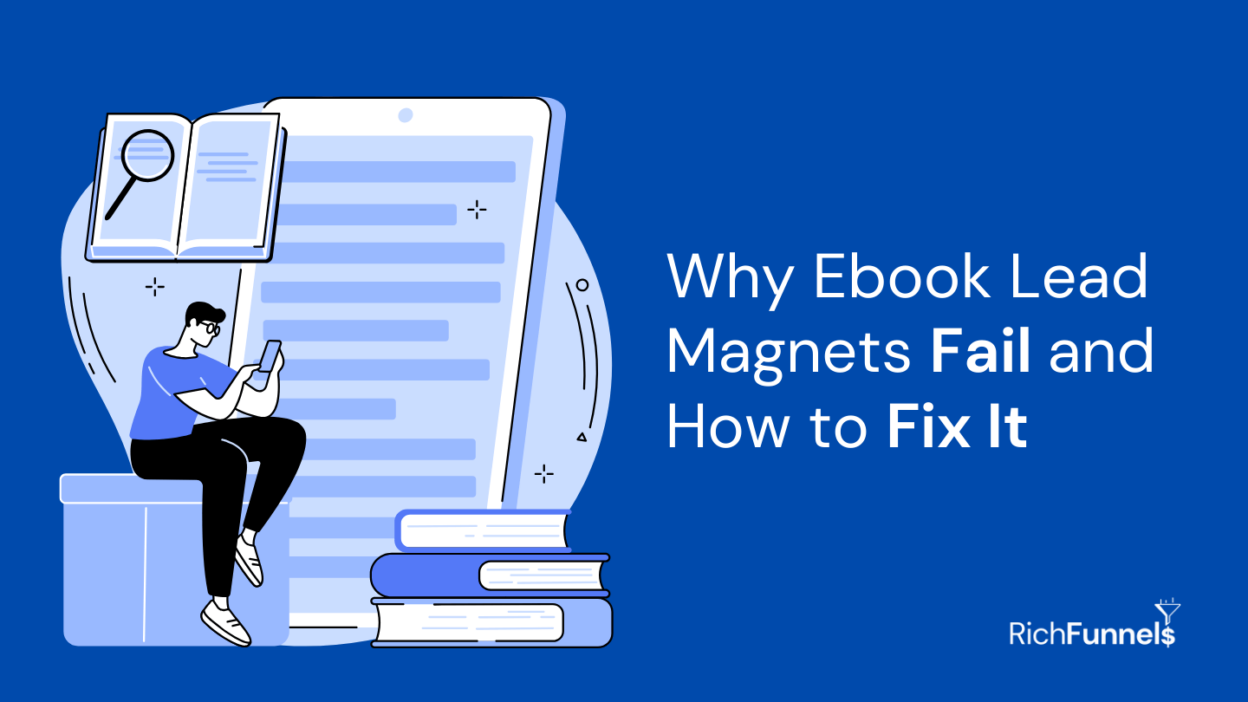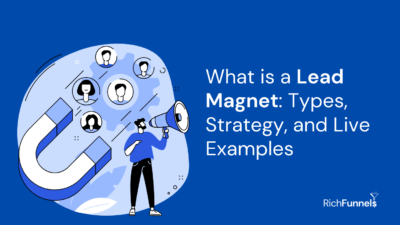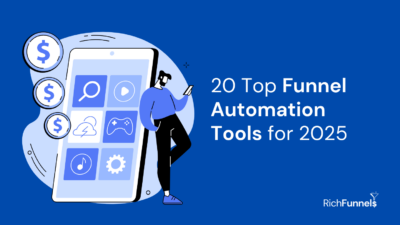Despite countless ebook examples flooding the digital marketing space, most fail to generate the leads businesses expect. What worked five years ago as a lead magnet now sits unopened in potential customers’ download folders.
In fact, traditional ebook lead magnets often struggle to capture attention in today’s fast-paced digital environment. The standard 30-page PDF guide that once attracted eager subscribers now faces stiff competition from shorter, more dynamic content formats.
This guide examines why most ebook lead magnets fall short and, more importantly, what actually works for converting visitors into subscribers. We’ll explore practical alternatives and show you how to transform existing ebooks into high-performing lead generation assets that today’s audiences actually want to consume.
The Psychology Behind Failed Ebook Lead Magnets
Understanding reader psychology reveals why traditional ebook lead magnets often miss their mark. Recent studies show a dramatic shift in content consumption patterns, with average screen attention spans dropping from 2.5 minutes in 2004 to just 47 seconds in recent years.
1. Modern attention spans and content consumption
Screen-based attention spans continue to shrink, with half of all measured interactions lasting 40 seconds or less. Furthermore, Microsoft’s research indicates human attention spans have decreased to eight seconds – nearly 25% shorter than just a few years ago. This shift primarily affects how readers engage with longer formats, as viewers retain 95% of messages through video compared to only 10% when reading text.

2. Cognitive overload in lengthy content
When processing information, human brains operate with limited capacity, similar to computers. Notably, cognitive overload occurs when working memory becomes overwhelmed, leading to decreased performance and difficulty concentrating. This explains why traditional ebook formats often struggle – readers face extraneous cognitive load from processing dense information, making it harder to absorb and retain key concepts.
2. The commitment barrier
The psychological resistance to lengthy content stems from several factors. Studies show that children as young as 2-4 years average 2.5 hours of screen time daily, establishing early patterns of quick-consumption behavior. Accordingly, this early conditioning affects how adults approach content, with 33% of users indicating they would spend more time with content if they could customize it to their interests.
Common Reasons Why Ebook Lead Magnets Fail
Research shows that 95% of ebook lead magnets fall short of their intended goals. This widespread failure stems from several key factors that businesses often overlook while creating their downloadable content.
1. Poor value proposition
Many ebook lead magnets lack a unique value proposition that sets them apart from freely available online content. Primarily, these resources fail because they don’t address specific problems or provide clear benefits to readers. Studies indicate that most lead magnets focus on ‘lazy problems’—issues that generate mild interest but don’t solve urgent challenges.
2. Overwhelming length and complexity
Length and complexity present significant barriers to engagement. Most readers never complete downloaded ebooks, regardless of how relevant or interesting the content might be. Additionally, businesses often make the mistake of cramming too much information into their ebooks, creating what experts call “content fatigue”. This overload occurs because creators frequently include excessive details without considering their audience’s time constraints or attention span.
3. Lack of immediate gratification
Modern readers seek quick solutions and actionable insights. Therefore, when lead magnets don’t deliver immediate value, engagement rates plummet. Here’s what makes ebooks particularly challenging:
- They require substantial time investment to consume
- They’re often difficult to navigate
- They lack interactive elements that maintain interest
Moreover, the perceived value of ebook lead magnets has depreciated over time. As target audiences become more sophisticated, they increasingly demand high-quality, practical content that promises immediate benefits rather than generic information that requires extensive reading time. Essentially, when readers don’t see tangible value within the first few minutes, they move on to other resources.
The impact of these failures extends beyond just lost leads. Poor quality ebooks can damage brand credibility and waste valuable marketing resources. Research shows that rushed lead magnets lacking quality thought or strategic placement need replacement more quickly, creating additional costs and effort.
The Hidden Costs of Poor Ebook Lead Magnets
The financial and operational impact of poorly executed ebook lead magnets extends far beyond mere download statistics. Initially, businesses overlook these hidden costs, which can significantly affect their marketing funnel success and bottom line.
1. Impact on brand credibility
First and foremost, subpar ebook content damages brand perception. When subscribers receive low-quality lead magnets that feel hastily assembled, they form negative impressions that persist long after the download. Subsequently, this erosion of trust affects future marketing efforts, as subscribers become skeptical of additional offerings and promotional messages.
2. Lost conversion opportunities
The cost of lost conversions manifests in multiple ways. Studies show that poorly designed lead magnets trigger immediate unsubscribe rates significantly higher than average. These quick departures create a cascade of negative effects:
- Decreased email deliverability scores
- Reduced content sharing potential
- Diminished future engagement opportunities
- Lost potential for customer referrals
Research indicates that businesses achieve exceptional results if even 10% of people who download their freebie actually consume it. Similarly, out of those who consume the content, only 1-2% typically take the next step in the customer journey.
3. Resource waste in creation and promotion
Ultimately, ineffective ebook lead magnets waste valuable business resources. The creation process demands significant time investment, yet many businesses rush through it, resulting in content that lacks strategic value. In turn, this leads to:
Poor lead magnets waste both creator and user time, as highlighted by marketing experts. Even more concerning, promotional efforts directed at ineffective lead magnets represent squandered marketing budgets, as these resources could be better allocated to more engaging content formats.
The ripple effect continues as businesses must frequently replace underperforming ebook examples with new content. This constant cycle of creation and replacement drains resources that could otherwise support more effective marketing initiatives. As a result, companies find themselves caught in a costly loop of producing content that fails to deliver meaningful returns on investment.
High-Converting Lead Magnet Alternatives
Successful marketers have discovered powerful alternatives to traditional ebook lead magnets that generate higher engagement and conversion rates. These modern approaches align with changing consumer preferences and deliver immediate value to prospects.
1. Quick-win templates and tools
Templates and tools offer immediate practical value, with conversion rates reaching up to 63%. Digital business templates, specifically, help prospects save time and resources by providing ready-to-use solutions. For instance, marketing template libraries have proven particularly effective, with some businesses reporting significant increases in subscriber growth.
A well-designed template delivers instant gratification by allowing users to customize and implement solutions immediately. Indeed, successful examples include email templates that enable quick customization and immediate use. Primarily, these resources work because they solve specific problems without requiring extensive time investment.
2. Interactive content formats
Interactive elements generate five times more engagement than static content. Specifically, quizzes and assessments have emerged as powerful lead generation tools, with some businesses reporting conversion rates as high as 38.8%. Meanwhile, interactive dashboards and calculators demonstrate impressive results, with some achieving conversion rates of 33%.
The success of interactive formats stems from their ability to:
- Provide personalized insights through user input
- Deliver immediate value through real-time results
- Create engaging experiences that maintain user interest
- Generate valuable data for better audience understanding
3. Micro-learning resources
Mini-courses and bite-sized content packages have become increasingly effective alternatives to lengthy ebooks. Generally, these resources break down complex topics into manageable segments, with some achieving conversion rates of 46%. Hence, their success lies in delivering quick, actionable insights without overwhelming the learner.
Email courses, likewise, prove particularly effective as they require no fancy downloadable content while maintaining high engagement. Overall, micro-learning resources succeed by providing structured, digestible content that respects users’ time constraints while delivering tangible value.
The effectiveness of these alternatives stems from their alignment with modern consumption habits. Although they differ in format, each option shares common traits: immediate value delivery, practical application, and respect for users’ time investment. These characteristics make them particularly appealing to today’s audience, who seek quick solutions to specific challenges.
Transforming Failed Ebooks Into Successful Lead Magnets
Breathing new life into underperforming ebook lead magnets requires strategic restructuring and modern engagement techniques. Recent data shows that properly optimized ebooks can achieve up to 40% higher engagement rates.
Content chunking strategies
Breaking down lengthy ebooks into digestible segments marks the first step in transformation. Studies indicate that readers spend an average of 12 minutes with interactive content, compared to just 8 minutes with traditional formats. First thing to remember, successful content chunking involves:
Breaking content into 5-10 minute reading segments has shown a 40% increase in completed downloads coupled with a 25% rise in lead conversions. Under those circumstances, businesses should focus on creating clear outlines and maintaining consistent structure throughout their ebooks.
Interactive element integration
Important to realize, interactive elements have emerged as game-changers in ebook engagement. By January 2024, major marketing platforms reported a 30% surge in interactive element usage within ebooks. These elements enhance reader experience through:
- Embedded quizzes and assessments
- Clickable sections with expandable content
- Interactive infographics and decision trees
- Mobile-optimized navigation features
- Real-time feedback mechanisms
Primarily, ebooks incorporating these interactive features demonstrate a 35% increase in qualified leads compared to static versions. In addition to engagement benefits, interactive elements provide valuable data for lead scoring and audience understanding.
Multi-format repurposing
Content repurposing maximizes the value of existing ebook material while catering to diverse audience preferences. Studies show that businesses effectively transform their best-performing content into multiple formats. Simultaneously, this approach allows for:
Mobile optimization has become crucial, with mobile-optimized ebooks seeing 35% more downloads than desktop-only versions. Furthermore, lead capture forms embedded in mobile-friendly formats show 20% higher completion rates.
The transformation process should prioritize vertical scrolling layouts and touch-friendly interactive elements. Content creators can take their most successful blog posts or webinars and convert them into engaging ebook formats. This strategy has proven particularly effective when combined with content upgrades, which can increase conversion rates from 0.54% to 4.82%.
For optimal results, businesses should regularly review and update their transformed content. Data shows that periodic content refreshes, coupled with strategic placement and promotion, significantly improve lead generation outcomes. Through proper implementation of these strategies, companies can revitalize their existing ebook content while maintaining brand consistency and professional design standards.





